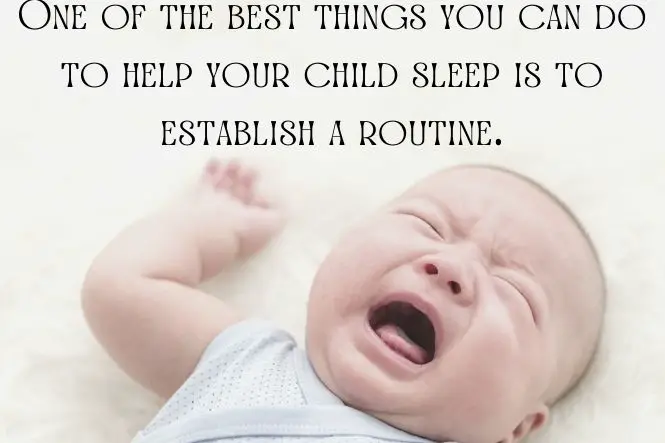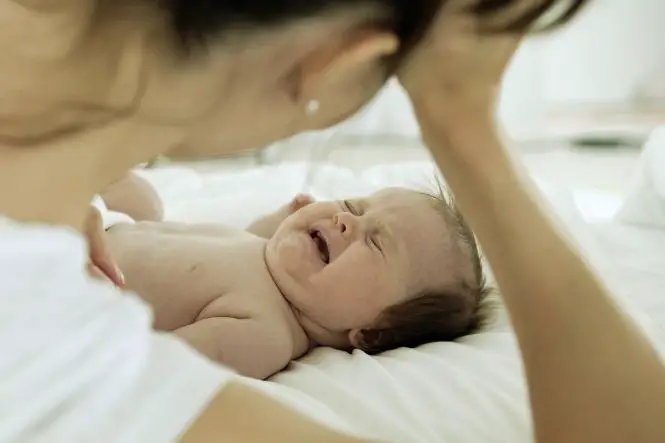The cry it out method is a controversial type of sleeping training that is used by some families to get their babies to sleep–it is also called the Ferber method and the extinction method. The purpose of the cry it out method is to have the baby fall asleep alone in their crib or bassinet, as opposed to falling asleep while they are being held, rocked, or fed. Parents or caregivers who use this method are expected to ignore their baby’s cries and not go into the bedroom to pick them up, soothe them, or comfort them.
Proponents of the cry it out method suggest that this process teaches babies how to self soothe so that they are able to fall asleep on their own; however, critics say that infants are simply not old enough to be able to soothe themselves and just fall asleep because they are exhausted from crying. There is no doubt that using this method can be upsetting for both baby and parents, though some say it is the best way to get your infant on a regular sleep schedule.
Whether you choose to use the cry it out method or another type of sleep training is up to you; it is important that you familiarize yourself with developmental guidelines for infants so that you know if your expectations are reasonable. The first few months of an infant’s life can be incredibly challenging and even more so when parents are struggling with a lack of sleep. Being aware of what is normal infant behavior can help you adjust to raising your newborn and making sure everyone in the family gets enough sleep.
Table of Contents
Does Crying It Out Work For Naps?
The cry it out method is most commonly used for getting babies to sleep at night, though some parents will also use it for nap time. In the early stages of infancy, babies will sleep for a large portion of the day, usually napping between three and five times. As babies get older, they will need fewer naps, often going down to twice a day around the age of six months, and once a day after they reach one year of age.
If using cry it out for naps, it is important that you pay close attention to how much sleep your baby is getting so that you aren’t just leaving them to cry when they aren’t even tired. For example, if your baby normally naps twice a day for 45 minutes each time, if you put them down for a third nap, they are likely to continue crying because they don’t need any more sleep. This can be confusing and upsetting for your child and should be avoided.
For the most part, crying it out is as useful at naptime as it is at bedtime but there are a few things to keep in mind. Most parents find that cry it out works better in the evening, likely because the room is darker and often the household is quieter–if your baby is having trouble napping during the day consider getting blackout curtains and a white noise machine. Also, remember that while some babies nap on a fairly regular schedule, this is not the case for every infant–just as adults are not always tired at the same time, infants are not either.
How Long Do You Let A Baby Cry It Out At Nap Time?
There are two types of methods for crying it out at nap time. One is to put your baby down in their crib and let them cry until they fall asleep–this means no going into the room and no talking to them. The other method is a more gradual approach where you periodically go into the baby’s room to help them settle down until they fall asleep.
With the first method, your baby may cry for just a few minutes before they fall asleep or they might cry for an hour or longer. Much of this depends on how tired they are, how new sleep training is for them, and how old the child is. Typically, older babies will cry for less time as compared to newborns and very young infants.
If you use the second method of crying it out, you might put your baby down and wait about three minutes before going into the room to help soothe them. Proponents of this method recommend not picking the child up, but simply rubbing their back and speaking softly to them for a minute, then leaving the room again. You would then gradually increase the amount of time you leave the baby to cry, for example, five minutes, then 10 minutes, and so on.
What Happens If Cry It Out Doesn’t Work?
If you have tried to get your baby to sleep using the cry it out method and it has not been successful, there are several other things you can do to help get your baby to sleep. One of the best things you can do to help your child sleep is to establish a routine. While many parents have a bedtime routine, they often forget that it’s just as important for naptime. Implement the same sort of practices you would at bedtime, for example, spending about 20 minutes involving your baby in a non-stimulating activity like quiet reading.

Having a routine gets your baby to associate these activities with getting ready to sleep. It’s also important that your baby has everything they need when being put down for a nap. Make sure that they have fed recently so that they aren’t going to bed hungry and also ensure that they have a dry diaper when they go down for a nap. Darken the room if you can and use a white noise machine to drown out household activity.
Temperature can be another factor that can impact your baby’s sleep–if it is too hot or too cold in their bedroom, this can interfere with nap time. You can also consider swaddling your baby–when they are wrapped up they are less likely to startle themselves awake with arm and leg movements. Remember to always put your baby to sleep on their back to reduce the chances of sudden infant death syndrome (SIDS).
At What Age Do Babies Self Soothe?
When a baby self soothes, it means that they are able to calm themselves without the help of the parent. It is important to know that babies learn how to do this from first being soothed by others–if a caregiver does not make the infant feel safe and loved, the baby will never learn to do this themselves. Young infants are not able to self soothe which is one reason why the cry it out method is criticized for babies of this age.
The majority of babies will start to exhibit self soothing behaviors around six months of age. This is the same time that many infants begin to sleep through the night–in part due to their capacity to calm themselves but also because they don’t require feeding as frequently. Keep in mind that every baby is different and develops at their own pace–be patient and trust that eventually your child will sleep through the night and you will be well rested!
Many parents like to give their baby a stuffed animal or a blanket to go to bed with. Due to the risk of SIDS, the American Academy of Pediatrics (AAP) recommends that babies do not have anything in their crib with them until they are at least 12 months old. Up until that age, your child should be dressed warmly enough that they don’t need a blanket when sleeping.
Do Babies Need a Sleep Schedule
Parents can be tempted to put their infants on a sleeping schedule in hopes that it will make life easier for everyone; however, there are some things you should know about babies and schedules. The main thing is that newborns sleep for the majority of the day–at this stage, it is not possible to have your baby on any sort of schedule. While it can be extremely tiring for parents to deal with multiple night wakings, the good news is this stage doesn’t last forever.
Once a baby is about three months old, you will be able to recognize patterns in their sleep. For example, babies tend to start sleeping more at night and less during the day after the three-month mark; some will sleep as much as five hours at a time during the night. At around six months, your baby may sleep for six hours straight but most likely wakes up once during the night.
A lot of babies will settle into some type of schedule on their own, napping regularly during the day and sleeping for longer periods at night. Notice when your baby starts to seem drowsy–if this generally occurs at the same time each day, this is a good indication that they are already settled into a pattern. Keep in mind that babies will not sleep if they are not tired–there is no use trying to force a schedule. Instead, instill routines that encourage longer sleeps at night and shorter naps during the day.
Final Thoughts
When it comes to babies and naptime, cry it out is just one option that parents have. Young infants do not have the capacity to soothe themselves back to sleep, so parents can expect to help with this process until babies reach at least six months. If you find that you are getting extremely frustrated with your infant, consider reaching out to your healthcare provider. Postpartum depression is a common experience among women and there is help available.





